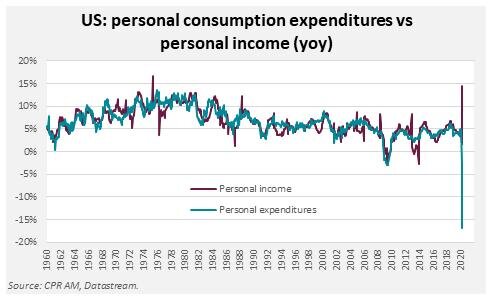
It isn’t flashy, trendy, or instantly rewarding. In fact, it’s contrary to all of those, yet this month, it’s fully en vogue.
Table of Content
It is saving. The age-old practice of living within your means, it turns out, has become cool again. Literally overnight, Americans went from saving a small fraction of their income to a whopping 33%. A third!
Just how big of a bump are piggy banks seeing? A record-breaking one. Double the previous record set in 1975. And weighing in at the all-time high since the beginning of record keeping.
Talk about a savings bonanza! Part of the bump is due to the $1200 stimulus checks that hit Americans’ bank accounts over the last two months. Those payments brought a bump to average personal income, which historically would have resulted in a spike in spending. By all appearances, it seems to have done the opposite. Check out this eye-popping chart showing the change in personal income and personal expenditures since 1960:

It turns out that when the future is uncertain, Americans are surprisingly capable of squashing their urges to spend. So what’s the result? It depends on whom you ask.
The Debatable Impact of Saving vs. Spending
Many believe that in the short-term, saving is bad for the economy. Short-term thinkers would much rather see those $1200 checks flow into the consumer-driven economy than sit in our bank accounts. They see the trickle-down effects to small businesses, large employers, suppliers, and so on. Their argument? Spend it.
Over the long-term, others say, such savings can prevent further economic distress. If more Americans have emergency savings a.k.a. “Rainy Day Funds,” fewer could fall into default on their mortgages, cars, etc. if times get tougher. Save it for a rainy day, they say.
In the middle of both arguments is yet another position called the “train station.” Even saved funds, they argue, will eventually be spent (“leave the station”), invested into stock or real estate, or given away. Saving, they say, is merely deferring a jolt to the economy. Those who save will likely spend it later – when doing so won’t carry additional risks, such as lacking a safety net.
Teaching Kids to Save
Deferred gratification is one of the major milestones of maturity. As such, saving is a difficult concept for most kids. The more tangible and concrete saving can feel, the more likely a kid is to follow through with it. If your child has their eye on a new $30 video game, for example, but they make $10 per week in their allowance, work with them to create a chart that has a checkbox for $2, $5, and $10 increments. They get to choose how big a box to check each week, and how much progress to make toward their goal. Rather than refusing their indulgence, they get to see the progress they’re making toward it. If only there were a patch for that…
Another way to teach the power of saving? Entertain them. Lucky for you, one of our core “learning pillars” is Saving & Investing. Our trove of video clips and activities make the topic enjoyable to teach and easy to understand. And for just $4.99, you can purchase our new Saving & Investing Bundle, including 7 profiles of real kids who’ve amassed some serious savings.

